Subtract a Value from every Number in a List in Python
Last updated: Apr 10, 2024
Reading time·4 min

# Table of Contents
- Subtract a value from every number in a List in Python
- Subtract a value from every number in a List using a
forloop - Subtract a value from every number in a List using NumPy
- Subtract a value from every number in a List using
map() - Subtract a value from every number in a List using enumerate
# Subtract a value from every number in a List in Python
To subtract a value from every number in a list:
- Use a list comprehension to iterate over the list.
- Use the subtraction
-operator to subtract a value from every number. - The new list will contain the results.
a_list = [5, 15, 25, 35, 45] a_list = [item - 5 for item in a_list] print(a_list) # 👉️ [0, 10, 20, 30, 40]
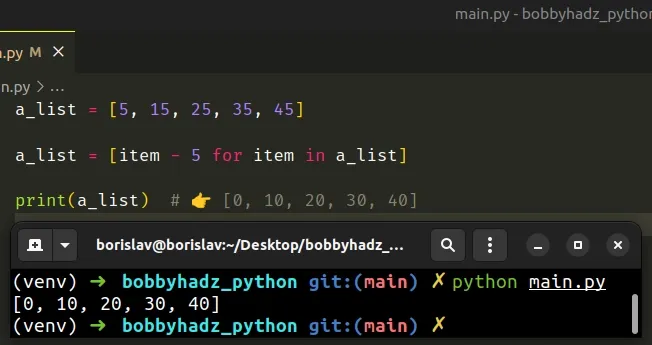
We used a
list comprehension to
iterate over the list and subtracted 5 from each number.
On each iteration, we subtract 5 from the current list item and return the
result.
Alternatively, you can use a simple for loop.
# Subtract a value from every number in a List using a for loop
This is a four-step process:
- Declare a new variable that stores an empty list.
- Use a
forloop to iterate over the original list. - On each iteration, subtract the number from the current item.
- Append the result to the new list.
a_list = [5, 15, 25, 35, 45] new_list = [] for item in a_list: new_list.append(item - 5) print(new_list) # 👉️ [0, 10, 20, 30, 40]
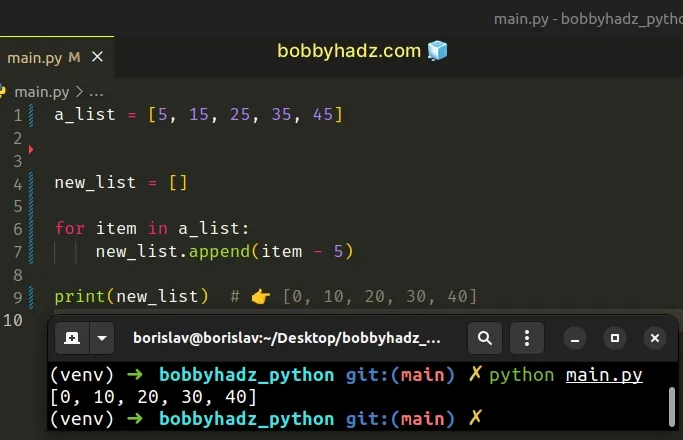
for loop works in a very similar way to the list comprehension, but instead of returning the list items directly, we append them to a new list.The list.append() method adds an item to the end of the list.
# Subtract a value from every number in a List using NumPy
If you use the numpy module, you can also subtract the number directly from a
numpy array.
import numpy as np arr = np.array([5, 15, 25, 35, 45]) arr = arr - 5 print(arr) # 👉️ [ 0 10 20 30 40] a_list = arr.tolist() print(a_list) # 👉️ [0, 10, 20, 30, 40]
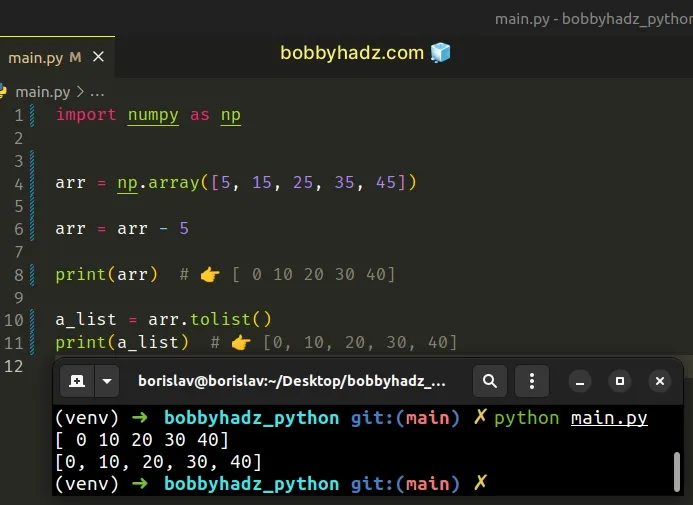
Make sure you have NumPy installed to be able to run the code sample.
pip install numpy # 👇️ or with pip3 pip3 install numpy
Subtracting a number from a numpy array effectively subtracts the number from
each element in the array.
Note that this only works with numpy arrays, you'd get a TypeError if you
try to subtract a number from a native Python list.
The
tolist
method converts a numpy array to a list.
Alternatively, you can use the map() function.
# Subtract a value from every number in a List using map()
This is a three-step process:
- Pass a lambda function and the list to the
map()function. - The lambda function should subtract the specific value from the provided list element.
- Use the
list()class to convert the map object to a list.
a_list = [5, 15, 25, 35, 45] new_list = list(map(lambda item: item - 5, a_list)) print(new_list) # 👉️ [0, 10, 20, 30, 40]
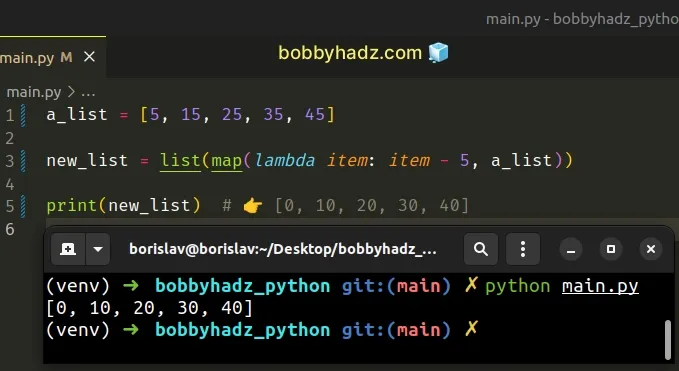
The map() function takes a function and an iterable as arguments and calls the function with each item of the iterable.
map gets called with each item in the list, subtracts 5 from the item and returns the result.The last step is to use the list() class to convert the map object to a
list.
Which approach you pick is a matter of personal preference. I'd use a list comprehension because I find them quite direct and easy to read.
# Subtract a value from every number in a List using enumerate
You can also use the enumerate() function to subtract a value from every
number in a list.
a_list = [5, 15, 25, 35, 45] for index, item in enumerate(a_list): a_list[index] = item - 5 # 👇️ [0, 10, 20, 30, 40] print(a_list)
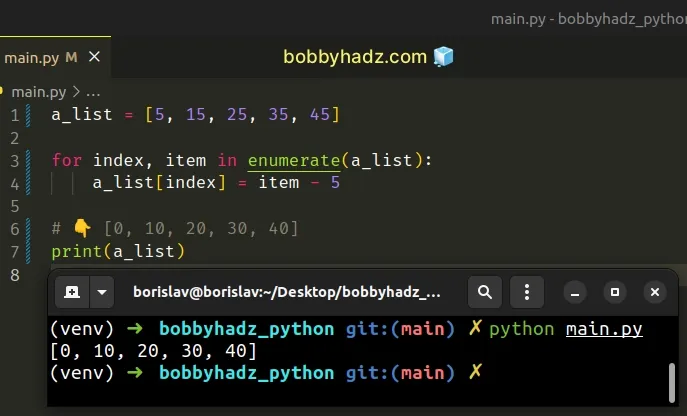
The enumerate() function takes an iterable and returns an enumerate object containing tuples where the first element is the index and the second is the corresponding item.
my_list = ['bobby', 'hadz', 'com'] for index, item in enumerate(my_list): print(index, item) # 👉️ 0 bobby, 1 hadz, 2 com
On each iteration, we use the index to assign to the current list item,
subtracting 5 from its value.
I've also written an article on how to sum all values in a dictionary or list of dictionaries.
# Additional Resources
You can learn more about the related topics by checking out the following tutorials:

